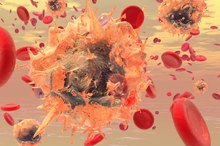The Increase of White Blood Cells in Newborns
White blood cells (WBCs) are a type of body cell found in the bloodstream that help fight infection 1. According to MedlinePlus, WBCs are also called leukocytes and the normal amount found in the bloodstream of a newborn infant is between 4,500 and 10,000 per microliter of blood 2. Most white blood cells form in the bone marrow and travel through the bloodstream to a site of infection 1.
If you are experiencing serious medical symptoms, seek emergency treatment immediately.
Types
There are five different types of white blood cells found in the body 1. Neutrophils are the most common type, and are responsible for consuming bacteria, fungi, viruses and protozoa. Eosinophils protect the body against infections caused by parasitic worms. Monocytes are white blood cells that live longer and ingest larger amounts of bacteria 1. Basophils increase inflammation in a targeted area of infection, and lymphocytes are special cells designed to attack tumors. Depending on which type of white blood cells are elevated, a doctor gets a clearer picture of the type of infection occurring 1.
Testing
What Are the Treatments for Low Platelets in Infants?
Learn More
White blood cell levels are tested in newborns by drawing a complete blood count (CBC). The CBC tests for other types of cells as well, including red blood cells, hemoglobin and platelets, as well as the levels of each type of white blood cell 1. To check a CBC in a newborn, the skin of the heel is punctured with a lancet, taking a small amount of blood for analysis. The CBC shows if the white blood cell count is high and which types of white blood cells are elevated 1.
Maternal Illness
An infant may be born with a high WBC count, also called leukocytosis, if her mother is ill during pregnancy and the infection is passed on. Chorioamnionitis is an infection of the amniotic fluid and the membranes surrounding the fetus. Chorioamnionitis causes abdominal pain and fever in a pregnant mother and may result in premature delivery. A baby born to a mother with chorioamnionitis may have leukocytosis if she is born with an infection and her body is trying to fight off invading bacteria.
- An infant may be born with a high WBC count, also called leukocytosis, if her mother is ill during pregnancy and the infection is passed on.
- Chorioamnionitis causes abdominal pain and fever in a pregnant mother and may result in premature delivery.
Infection
Nystatin Side Effects for Infants
Learn More
Newborn leukocytosis may be related to infection that an infant develops after birth. The condition is more commonly seen among infants who are born prematurely at less than 36 weeks gestation. Infection can affect any of the body systems, and other manifestations may develop that are directly related to the organs involved. For example, a newborn infant with gastrointestinal infection may have an increased white blood cell count, abdominal distention and diarrhea.
- Newborn leukocytosis may be related to infection that an infant develops after birth.
Considerations
Resolving leukocytosis in the newborn involves treating the underlying infection, and doctors typically prescribe antibiotics. Although a baby may respond to medication and symptoms of illness may lessen, it may take longer for the white blood cell count to return to normal. An elevated white blood cell count is not the only indicator of infection in a newborn. Physicians must look at the baby’s history as well as assess for the presence of other symptoms to verify the newborn has an infection before administering treatment.
- Resolving leukocytosis in the newborn involves treating the underlying infection, and doctors typically prescribe antibiotics.
- Although a baby may respond to medication and symptoms of illness may lessen, it may take longer for the white blood cell count to return to normal.
Related Articles
References
- Wisc-Online: White Blood Cells
- MedlinePlus: WBC count
- “Foundations of Maternal-Newborn Nursing;” T.M. Gorrie, E.S. McKinney & S. S. Murray; 1998
- U.S. Library of Medicine. MedlinePlus. White Blood Cell Count. https://medlineplus.gov/ency/article/003643.htm
- Mayadas TN, Cullere X, Lowell CA. The multifaceted functions of neutrophils. Annu Rev Pathol. 2014;9:181-218. doi:10.1146/annurev-pathol-020712-164023
- Mcbrien CN, Menzies-gow A. The Biology of Eosinophils and Their Role in Asthma. Front Med (Lausanne). 2017;4:93. doi:10.3389/fmed.2017.00093
- Cromheecke JL, Nguyen KT, Huston DP. Emerging role of human basophil biology in health and disease. Curr Allergy Asthma Rep. 2014;14(1):408. doi:10.1007/s11882-013-0408-2
- Hoffman W, Lakkis FG, Chalasani G. B Cells, Antibodies, and More. Clin J Am Soc Nephrol. 2016;11(1):137-54. doi:10.2215/CJN.09430915
- Karlmark KR, Tacke F, Dunay IR. Monocytes in health and disease - Minireview. Eur J Microbiol Immunol (Bp). 2012;2(2):97-102. doi:10.1556/EuJMI.2.2012.2.1
- Görgens A, Radtke S, Horn PA, Giebel B. New relationships of human hematopoietic lineages facilitate detection of multipotent hematopoietic stem and progenitor cells. Cell Cycle. 2013;12(22):3478-82. doi:10.4161/cc.26900
- Hong JW, Noh JH, Kim DJ. Association between White Blood Cell Counts within Normal Range and Hemoglobin A1c in a Korean Population. Endocrinol Metab (Seoul). 2018;33(1):79-87. doi:10.3803/EnM.2018.33.1.79
- Riley LK, Rupert J. Evaluation of Patients with Leukocytosis. Am Fam Physician. 2015;92(11):1004-11.
- Flores-mireles AL, Walker JN, Caparon M, Hultgren SJ. Urinary tract infections: epidemiology, mechanisms of infection and treatment options. Nat Rev Microbiol. 2015;13(5):269-84. doi:10.1038/nrmicro3432
- Kasi PM, Grothey A. Chemotherapy-Induced Neutropenia as a Prognostic and Predictive Marker of Outcomes in Solid-Tumor Patients. Drugs. 2018;78(7):737-745. doi:10.1007/s40265-018-0909-3
- U.S. Library of Medicine. MedlinePlus. White Blood Cell Count.
Resources
Writer Bio
Meg Brannagan has worked as a registered nurse for more than 10 years, specializing in women's and children's health. She holds a bachelor's degree in nursing from the University of Nebraska Medical Center.








